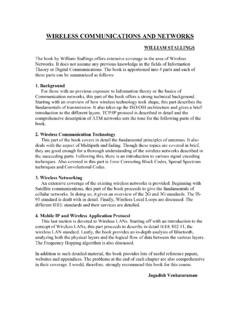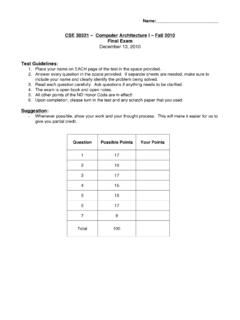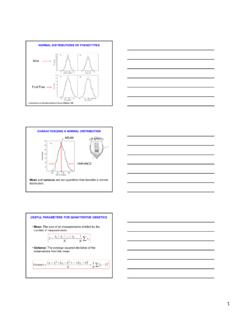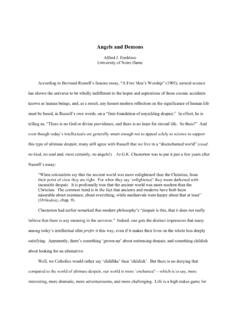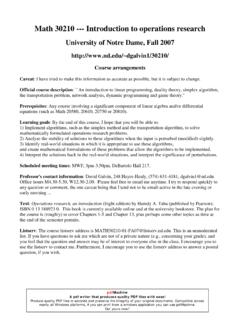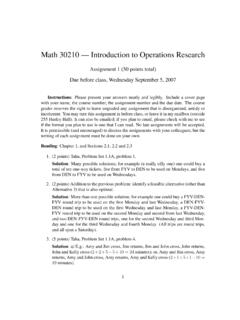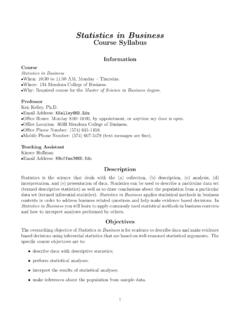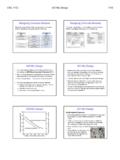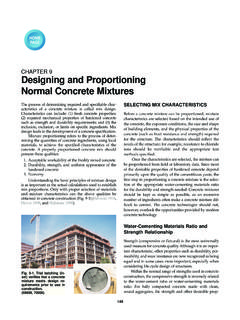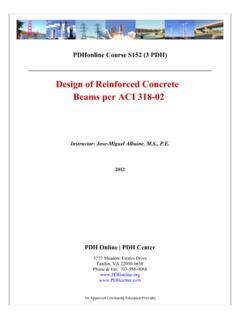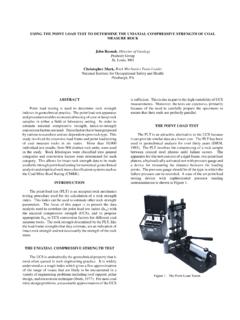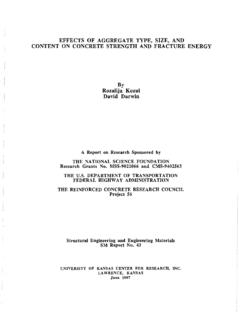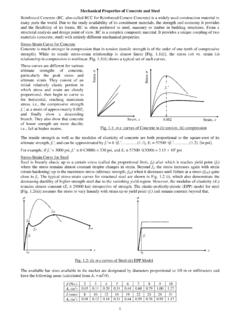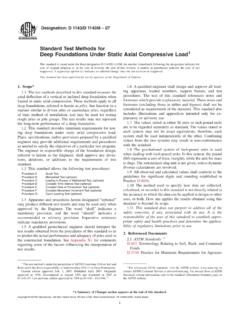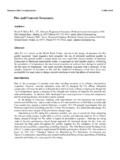Transcription of Rock Mechanics
1 Rock Mechanics !Response of rocks to Applied Loads!CE/SC 10110/20110 Planet Earth Rock Mechanics !Response of rocks to Applied Loads!! Earth materials rocks Soils Fluids ! rocks Solid, dense aggregates of mineral grains ! Soils Anything that can be excavated by a shovel ! Fluids Water, magma, petroleum, natural gas, atmosphere Phase Relationships in Earth Materials!! rocks can be considered as three-phase systems in most cases Solid, liquid, gas ! Most rocks contain some void space between grains Voids are always filled with some type of fluid - either liquid or gas Amount of void space & amount and type of fluid influence mechanical behavior of the material !
2 Porosity and void ratio - parameters used to quantify relative amount of void space Porosity (%) n = Vv / VT Vv = Void volume, VT = Total rock volume Void ratio (decimal) e = Vv / Vs Vv = Void volume, VS = Volume of solids Permeability - rate at which fluids will move through a saturated material ! Determined by size and connectedness of voids, and fluid properties (temperature, viscosity, density) ! Intrinsic permeability, k (cm2 or darcys) - permeability defined by the property of the material Size, shape, packing of the grains Degree of cementation Degree of fracturing !
3 Hydraulic Conductivity, K (cm/s, m/s) - measure of the ability of a rock or soil to transmit water K = k*[( g)/ ] k = intrinsic permeability = density of water = viscosity of water g = acceleration due to gravity 4 Phase Relationships in Earth Materials!! High porosity and permeability materials have high hydraulic conductivity ! Importance? Wells, oil deposits, Permeability and Hydraulic Conductivity!(Brief Summary)!Unfractured Igneous Low k Low K Shale Low k Low K Karst limestone High k High K Gravel High k High K ! Pressure - force per unit area applied to solid by a load !
4 Stress - pressure transmitted from the external face to an internal location, also force per unit area ! Types of stresses compressive - stresses of equal magnitude that act toward a point from opposite directions Tensile - stresses of equal magnitude that act away from a point Shear - stresses that are offset from one another and act in opposite directions Stress, Strain, Deformation Characteristics! compressive !tensile!shea r!6 ! At any point within an Stresses can be resolved into three principle stresses that are mutually perpendicular ( 1, 2, 3) Maximum, intermediate and minimum stress 7 Stress, Strain, Deformation Characteristics!
5 ! On any plane within an There is a normal stress ( n) perpendicular to the plane and shear stress ( ) acting parallel to the plane ! Vertical stress v acting on a horizontal plane at shallow depth h can be calculated as: v = h + Pa = unit weight of rock h = depth to point below surface Pa = atmospheric pressure (usually neglected) This equation assumes a consistent body of rock above point If multiple layers of different rock v = aha + bhb + chc .. 8 Stress, Strain, Deformation Characteristics!Stress, Strain, Deformation Characteristics!
6 ! Previous equation can be applied if we wish to determine the stress on the major (horizontal) principle plane. Stress, Strain, Deformation Characteristics!! What if we want to know the stress on an inclined plane? Mohr s Circle Mohr Circle: Graphical representation of shear and normal stresses on inclined planes Stress, Strain, Deformation Characteristics! 13 ! Application of stress causes a body of rock to yield or deform. ! The amount of deformation is called strain ! The type and amount of strain that a particular material experiences depends on: Type of stresses applied Depth and temperature Deformation - Response to Stress!
7 14 Ideal Materials ! Elastic ( spring) Linear regression on a plot of stress vs strain Slope of regression line is modulus of elasticity E = / ; = applied stress; = strain Strain is change in length vs original length $$$ = L / L Strain in elastic systems is recoverable 15 Deformation - Response to Stress!Ideal Materials ! Viscous (fluids) Linear regression in a plot of stress vs strain rate Viscosity is slope of regression line in a stress-strain rate plot ! Plastic No strain until some critical stress value has been reached; then continuous deformation 16 Deformation - Response to Stress!
8 Fig. textbook Rock behavior is more complex than ideal materials Common method of testing rock behavior is the unconfined compression test 17 Deformation - Response to Stress!Generalized stress-strain curve for rocks Stress/strain relationships are generally not linear Usually show 3 distinct segments: 18 Deformation - Response to Stress!Region 1: closing of void spaces Region 2: approximately elastic behavior Region 3: approximately plastic behavior Failure: rock breaks and loses all shear strength ! Different types of rocks vary considerably in their stress-strain behavior !
9 Two types of responses Brittle - respond in a mostly elastic fashion until failure Ductile - respond elastically until the Elastic Limit , then in plastic fashion until failure 19 Deformation - Response to Stress!! Failure of a brittle rock - point when the rock loses all resistance to stress and crumbles. ! In plastic material, specific point of failure difficult to identify - because deformation continues indefinitely at a constant level of stress. ! strength (in plastic materials) is defined as the level of stress at failure. compressive strength !
10 20 ! On a plane within a rock Normal stresses tend to resist failure Shear stresses tend to cause failure If shear stress exceeds the shear strength - failure occurs 21 compressive strength !! relationship between shear and normal stresses during a strength test (and at failure) is critical to understanding deformation behavior of the material ! Way to test shear strength - Direct shear test Variable shear and normal stresses can be applied 22 compressive strength !! For unconsolidated materials ( dry sand) the relationship between normal stress ( n) and shear strength (S) is linear, passes through the origin: S = n tan 23 compressive strength !
